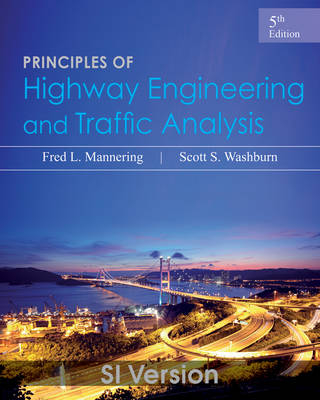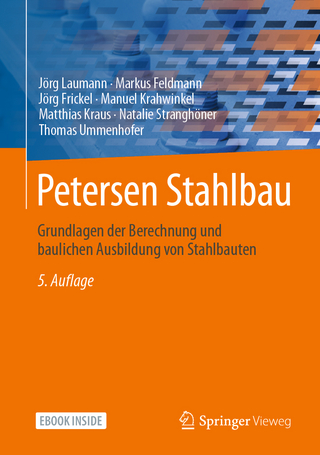
Principles of Highway Engineering and Traffic Analysis
John Wiley & Sons Inc (Verlag)
978-1-118-47139-5 (ISBN)
- Titel ist leider vergriffen;
keine Neuauflage - Artikel merken
Preface Chapter 1 Introduction to Highway Engineering and Traffic Analysis 1.1 Introduction 1.2 Highways and the Economy 1.2.1 The Highway Economy 1.2.2 Supply Chains 1.2.3 Economic Development 1.3 Highways, Energy, and the Environment 1.4 Highways as Part of the Transportation System 1.5 Highway Transportation and the Human Element 1.5.1 Passenger Transportation Modes and Traffic Congestion 1.5.2 Highway Safety 1.5.3 Demographic Trends 1.6 Highways and Evolving Technologies 1.6.1 Infrastructure Technologies 1.6.2 Vehicle Technologies 1.6.3 Traffic Control Technologies 1.7 Scope of Study Chapter 2 Road Vehicle Performance 2.1 Introduction 2.2 Tractive Effort and Resistance 2.3 Aerodynamic Resistance 2.4 Rolling Resistance 2.5 Grade Resistance 2.6 Available Tractive Effort 2.6.1 Maximum Tractive Effort 2.6.2 Engine-Generated Tractive Effort 2.7 Vehicle Acceleration 2.8 Fuel Efficiency 2.9 Principles of Braking 2.9.1 Braking Forces 2.9.2 Braking Force Ratio and Efficiency 2.9.3 Antilock Braking Systems 2.9.4 Theoretical Stopping Distance 2.9.5 Practical Stopping Distance 2.9.6 Distance Traveled During Driver Perception/Reaction Chapter 3 Geometric Design of Highways 3.1 Introduction 3.2 Principles of Highway Alignment 3.3 Vertical Alignment 3.3.1 Vertical Curve Fundamentals 3.3.2 Stopping Sight Distance 3.3.3 Stopping Sight Distance and Crest Vertical Curve Design 3.3.4 Stopping Sight Distance and Sag Vertical Curve Design 3.3.5 Passing Sight Distance and Crest Vertical Curve Design 3.3.6 Underpass Sight Distance and Sag Vertical Curve Design 3.4 Horizontal Alignment 3.4.1 Vehicle Cornering 3.4.2 Horizontal Curve Fundamentals 3.4.3 Stopping Sight Distance and Horizontal Curve Design 3.5 Combined Vertical and Horizontal Alignment Chapter 4 Pavement Design 4.1 Introduction 4.2 Pavement Types 4.2.1 Flexible Pavements 4.2.2 Rigid Pavements 4.3 Pavement System Design: Principles for Flexible Pavements 4.4 Traditional AASHTO Flexible-Pavement Design Procedure 4.4.1 Serviceability Concept 4.4.2 Flexible-Pavement Design Equation 4.4.3 Structural Number 4.5 Pavement System Design: Principles for Rigid Pavements 4.6 Traditional AASHTO Rigid-Pavement Design Procedure 4.7 Measuring Pavement Quality and Performance 4.7.1 International Roughness Index 4.7.2 Friction Measurements 4.7.3 Rut Depth 4.7.4 Cracking 4.7.5 Faulting 4.7.6 Punchouts 4.8 Mechanistic-Empirical Pavement Design Chapter 5 Fundamentals of Traffic Flow and Queuing Theory 5.1 Introduction 5.2 Traffic Stream Parameters 5.2.1 Traffic Flow, Speed, and Density 5.3 Basic Traffic Stream Models 5.3.1 Speed-Density Model 5.3.2 Flow-Density Model 5.3.3 Speed-Flow Model 5.4 Models of Traffic Flow 5.4.1 Poisson Model 5.4.2 Limitations of the Poisson Model 5.5 Queuing Theory and Traffic Flow Analysis 5.5.1 Dimensions of Queuing Models 5.5.2 D/D/1 Queuing 5.5.3 M/D/1 Queuing 5.5.4 M/M/1 Queuing 5.5.5 M/M/N Queuing 5.6 Traffic Analysis at Highway Bottlenecks Chapter 6 Highway Capacity and Level-of-Service Analysis 6.1 Introduction 6.2 Level-of-Service Concept 6.3 Level-of-Service Determination 6.3.1 Base Conditions and Capacity 6.3.2 Determining Free-Flow Speed 6.3.3 Determining Analysis Flow Rate 6.3.4 Calculating Service Measure(s) and Determining LOS 6.4 Basic Freeway Segments 6.4.1 Base Conditions and Capacity 6.4.2 Service Measure 6.4.3 Determining Free-Flow Speed 6.4.4 Determining Analysis Flow Rate 6.4.5 Calculating Density and Determining LOS 6.5 Multilane Highways 6.5.1 Base Conditions and Capacity 6.5.2 Service Measure 6.5.3 Determining Free-Flow Speed 6.5.4 Determining Analysis Flow Rate 6.5.5 Calculating Density and Determine LOS 6.6 Two-Lane Highways 6.6.1 Base Conditions and Capacity 6.6.2 Service Measures 6.6.3 Determine Free-Flow Speed 6.6.4 Determine Analysis Flow Rate 6.6.5 Calculating Service Measures 6.6.6 Determining LOS 6.7 Design Traffic Volumes Chapter 7 Traffic Control and Analysis at Signalized Intersections 7.1 Introduction 7.2 Intersection and Signal Control Characteristics 7.2.1 Actuated Control 7.2.2 Signal Controller Operation 7.3 Traffic Flow Fundamentals for Signalized Intersections 7.4 Development of a Traffic Signal Phasing and Timing Plan 7.4.1 Select Signal Phasing 7.4.2 Establish Analysis Lane Groups 7.4.3 Calculate Analysis Flow Rates and Adjusted Saturation Flow Rates 7.4.4 Determine Critical Lane Groups and Total Cycle Lost Time 7.4.5 Calculate Cycle Length 7.4.6 Allocate Green Time 7.4.7 Calculate Change and Clearance Intervals 7.4.8 Check Pedestrian Crossing Time 7.5 Analysis of Traffic at Signalized Intersections 7.5.1 Signalized Intersection Analysis with D/D/1 Queuing 7.5.2 Signal Coordination 7.5.3 Control Delay Calculation for Level of Service Analysis 7.5.4 Level-of-Service Determination Chapter 8 Travel Demand and Traffic Forecasting 8.1 Introduction 8.2 Traveler Decisions 8.3 Scope of the Travel Demand and Traffic Forecasting Problem 8.4 Trip Generation 8.4.1 Typical Trip Generation Models 8.4.2 Trip Generation with Count Data Models 8.5 Mode and Destination Choice 8.5.1 Methodological Approach 8.5.2 Logit Model Applications 8.6 Highway Route Choice 8.6.1 Highway Performance Functions 8.6.2 User Equilibrium 8.6.3 Mathematical Programming Approach to User Equilibrium 8.6.4 System Optimization 8.7 Traffic Forecasting in Practice 8.8 The Traditional Four-Step Process 8.9 The Current State of Travel Demand and Traffic Forecasting Appendix 8A Least Squares Estimation Appendix 8B Maximum-Likelihood Estimation
| Erscheint lt. Verlag | 18.1.2013 |
|---|---|
| Verlagsort | New York |
| Sprache | englisch |
| Maße | 203 x 252 mm |
| Gewicht | 728 g |
| Themenwelt | Technik ► Bauwesen |
| Technik ► Elektrotechnik / Energietechnik | |
| ISBN-10 | 1-118-47139-3 / 1118471393 |
| ISBN-13 | 978-1-118-47139-5 / 9781118471395 |
| Zustand | Neuware |
| Haben Sie eine Frage zum Produkt? |
aus dem Bereich


